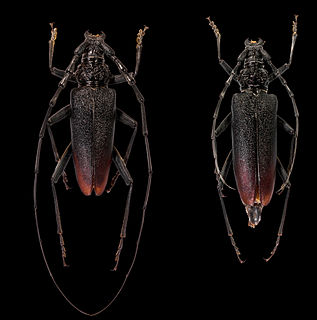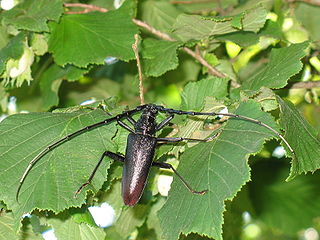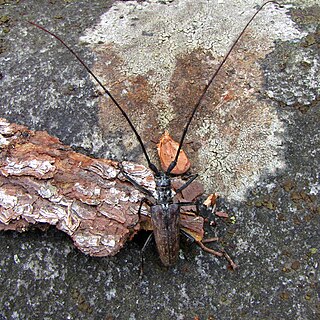
Giovanni Antonio Scopoli was an Austrian physician and naturalist. His biographer Otto Guglia named him the "first anational European" and the "Linnaeus of the Austrian Empire".

Cerambyx cerdo, commonly known as the great capricorn beetle or cerambyx longicorn, is a species of beetle in family Cerambycidae. It occurs in North Africa, Europe, and Asia.

Cerambyx is a genus of beetles in the family Cerambycidae. They are commonly known as capricorn beetles, as their strong, stout and curved antennae, each segment of which flares towards the tip, are reminiscent of the horns of an Alpine Ibex or "capricorn".
In the 10th edition of Systema Naturae, Carl Linnaeus classified the arthropods, including insects, arachnids and crustaceans, among his class "Insecta". Insects with hardened wing covers were brought together under the name Coleoptera.
In Greek mythology, Cĕrambus, a son of Euseiros and the nymph Eidothea of Othreis.

Cerambycini is a tribe of longhorn beetles classified under the subfamily Cerambycinae.

Dorcadion scopolii is a species of longhorn beetle in the subfamily Lamiinae.

Exocentrus is a genus of longhorn beetles of the subfamily Lamiinae.

Leiopus nebulosus is a species of longhorn beetle of the subfamily Lamiinae. It was described by Carl Linnaeus in his landmark 1758 10th edition of Systema Naturae. It contains two subspecies; the first, L. nebulosus nebulosus, is known from Europe and Russia, and the second, L. nebulosus caucasicus, is endemic to the mountains of the Caucasus. The beetles inhabit deciduous trees, including those in the genera Fagus, Quercus, Carpinus, Juglans, Acer, Ulmus, Betula, Salix, and Prunus. They measure 5–10 millimetres in length, and can live for approximately 1–2 years.

Batus barbicornis is a species of beetle in the family Cerambycidae. It was described by Carl Linnaeus in 1764.

Dorcadion aethiops is a species of beetle in the family Cerambycidae. It was described by Scopoli in 1763, originally under the genus Cerambyx. It is known from the Czech Republic, Albania, Greece, Bulgaria, Croatia, Hungary, Slovakia, North Macedonia, Romania, Austria, Turkey, Serbia, and Ukraine.

Dorcadion carinatum is a species of beetle in the family Cerambycidae. It was described by Peter Simon Pallas in 1771, originally under the genus Cerambyx. It is known from Russia, Azerbaijan, Kazakhstan, Georgia, and Ukraine.
Gnoma longicollis is a species of beetle in the family Cerambycidae. It was described by Johan Christian Fabricius in 1787 originally under the genus Cerambyx. It is known from Malaysia, Borneo, Singapore, India and Sumatra.

Monochamus sutor is a species of beetle in the family Cerambycidae. It was described by Carl Linnaeus in 1758, originally under the genus Cerambyx. It has a wide, natural distribution throughout Europe, and has also been introduced into Belgium and the Netherlands. Adults measure between 15 to 24 mm, and larvae measure up to 45 mm (1.8 in).

Monochamus notatus, the northeastern pine sawyer or notable sawyer, is a species of beetle in the family Cerambycidae. It was described by Dru Drury in 1773, originally under the genus Cerambyx. It is known from Canada and the United States.
Herophila fairmairei is a species of beetle in the family Cerambycidae. It was described by James Thomson in 1857 and is found in Greece. Herophila faurmairei live 2-3 years and are 12-25 mm in length.

Herophila tristis is a species of beetle in the family Cerambycidae, they are also called longhorned beetles. It was described by Carl Linnaeus in 1767, originally under the genus Cerambyx. It is known from Italy, Romania, Austria, Bulgaria, Crete, Croatia, Sardinia, France, Greece, Serbia, Corsica, Sicily, Hungary, Slovenia, Albania, and Turkey. It feeds on Morus alba, Ficus carica, and Robinia pseudoacacia. They live 2-3 years and are 13 - 26 mm long. Larvae feed under the bark of a range of broad-leaved trees, mostly Ficus carica commonly known as fig trees. As an adult they hide in the day and come out in the dusk.

Phryneta verrucosa is a species of beetle in the family Cerambycidae. It was described by Dru Drury in 1773, originally under the genus Cerambyx. It is known from Equatorial Guinea, and was introduced into Barbados, Grenada, and Trinidad and Tobago.

Cerambyx welensii is a species of beetle in the family Cerambycidae.















